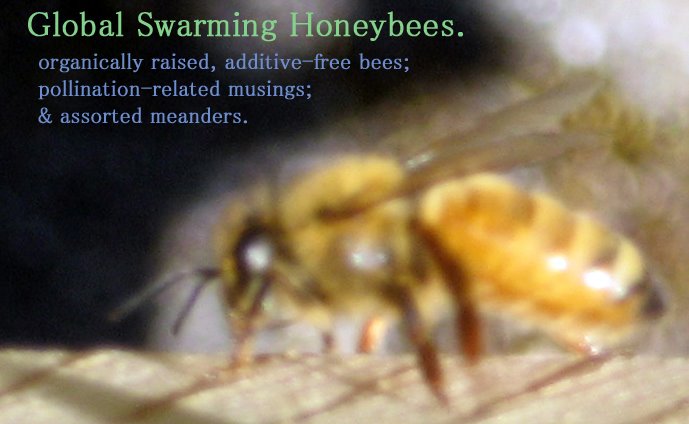 I love the dollops of cheerful color zinnias contribute to the end of the summer and early fall. It's like they're pitching in to make the shifting season a bit less depressing. The palette reminds me of those jumbo boxes of Crayola crayons—you know, the much-coveted 64-pack of the mid-1970s.
I love the dollops of cheerful color zinnias contribute to the end of the summer and early fall. It's like they're pitching in to make the shifting season a bit less depressing. The palette reminds me of those jumbo boxes of Crayola crayons—you know, the much-coveted 64-pack of the mid-1970s. The zinnias—in their "Different Brilliant Colors"—provide one of the garden's last nectar sources for the honeybees and other pollinators. Zinnia + borage + sunflowers + tomatillo blossoms = all that remains on the garden front, nectar-wise. (Fortunately, even after last week's light frost, the fields remain rich in goldenrod and aster, which the bees are working with frenzied effort as the foraging season winds down.)
The zinnias—in their "Different Brilliant Colors"—provide one of the garden's last nectar sources for the honeybees and other pollinators. Zinnia + borage + sunflowers + tomatillo blossoms = all that remains on the garden front, nectar-wise. (Fortunately, even after last week's light frost, the fields remain rich in goldenrod and aster, which the bees are working with frenzied effort as the foraging season winds down.) The zinnia is also popular with the bumblebees, who—like the honeybees—are in a race against time to gather enough food to overwinter.
The zinnia is also popular with the bumblebees, who—like the honeybees—are in a race against time to gather enough food to overwinter.This bumblebee captured my attention the other day, not only for its impressive size, but because it was slow-going, which made it possible for me to enjoy the sight of the morning sunlight illuminating its fuzzy exterior. Bumblebees are usually more skittish than honeybees, and quicker to buzz off, as it were, when the paparazzi arrives.

 But then something else caught my attention. If you click on the photo immediately above and look closely, you'll get a sense of what I mean.
But then something else caught my attention. If you click on the photo immediately above and look closely, you'll get a sense of what I mean.See the pic below for a better look.
 What we had here was an interesting stand-off between a flower spider and a very ample bumblebee. The spider—which relies on ambush (rather than a web) to capture its prey—gingerly probed the bumblebee (as shown below) and apparently decided against a tussle. (Another case for the annals of the Don't-Bite-Off-More-Than-You-Can-Chew Dept.)
What we had here was an interesting stand-off between a flower spider and a very ample bumblebee. The spider—which relies on ambush (rather than a web) to capture its prey—gingerly probed the bumblebee (as shown below) and apparently decided against a tussle. (Another case for the annals of the Don't-Bite-Off-More-Than-You-Can-Chew Dept.) Here's a better look at the spider in question.
Here's a better look at the spider in question. About an hour later, I returned to the scene of the non-crime and found that the spider had succeeded in biting off something it could chew—namely, an unlucky honeybee. In the pictures below, taken over the course of about a half-hour, you can see the spider feeding on its prey.
About an hour later, I returned to the scene of the non-crime and found that the spider had succeeded in biting off something it could chew—namely, an unlucky honeybee. In the pictures below, taken over the course of about a half-hour, you can see the spider feeding on its prey.

 Within the hour, the bee had been discarded and the spider was lying it wait for its next victim (and, I suppose, digesting).
Within the hour, the bee had been discarded and the spider was lying it wait for its next victim (and, I suppose, digesting).Some beekeepers become incensed when predators "get" their bees. Birds, for example, are described in some beekeeping guides as "pests" of the honeybee. So are frogs, which have enough troubles of their own without being maligned by beekeeping textbooks. I've even read posts from people on organic beek groups threatening to shoot cardinals or scarlet tanagers who "dare" to pick off their bees.
Please. That's the way the food chain crumbles. Yes, I'm saddened to see a bee taken by a spider or bird or whatever, but I also know that bees are no more exempt from the food chain system than the rest of us (lest we forget that we too become grist for the nature-mill, by and by). One reason Mother Nature, in her pretty much infinite wisdom, creates colonies consisting of tens of thousands of honeybees is that danger, predation, mortality are part of the game. Deal with it.
Besides, I like spiders. Is that so wrong?

Wow amazing pictures, Gerry. Thanks for posting them.
ReplyDelete